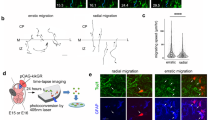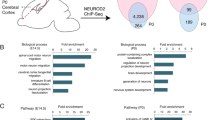Abstract
During neocortical development, the neuroepithelial or neural precursor cells that commit to neuronal fate need to delaminate and start migration toward the pial surface. However, the mechanism that couples neuronal fate commitment to detachment from the neuroepithelium remains largely unknown. Here we show that Scratch1 and Scratch2, members of the Snail superfamily of transcription factors, are expressed upon neuronal fate commitment under the control of proneural genes and promote apical process detachment and radial migration in the developing mouse neocortex. Scratch-induced delamination from the apical surface was mediated by transcriptional repression of the adhesion molecule E-cadherin. These findings suggest that Scratch proteins constitute a molecular link between neuronal fate commitment and the onset of neuronal migration. On the basis of their similarity to proteins involved in the epithelial-mesenchymal transition (EMT), we propose that Scratch proteins mediate the conversion of neuroepithelial cells to migrating neurons or intermediate neuronal progenitors through an EMT-related mechanism.
This is a preview of subscription content, access via your institution
Access options
Subscribe to this journal
Receive 12 print issues and online access
$209.00 per year
only $17.42 per issue
Buy this article
- Purchase on Springer Link
- Instant access to full article PDF
Prices may be subject to local taxes which are calculated during checkout







Similar content being viewed by others
Accession codes
References
Götz, M. & Huttner, W.B. The cell biology of neurogenesis. Nat. Rev. Mol. Cell Biol. 6, 777–788 (2005).
Kriegstein, A. & Alvarez-Buylla, A. The glial nature of embryonic and adult neural stem cells. Annu. Rev. Neurosci. 32, 149–184 (2009).
Imai, F. et al. Inactivation of aPKCλ results in the loss of adherens junctions in neuroepithelial cells without affecting neurogenesis in mouse neocortex. Development 133, 1735–1744 (2006).
Rasin, M.R. et al. Numb and Numbl are required for maintenance of cadherin-based adhesion and polarity of neural progenitors. Nat. Neurosci. 10, 819–827 (2007).
Kadowaki, M. et al. N-cadherin mediates cortical organization in the mouse brain. Dev. Biol. 304, 22–33 (2007).
Hand, R. et al. Phosphorylation of Neurogenin2 specifies the migration properties and the dendritic morphology of pyramidal neurons in the neocortex. Neuron 48, 45–62 (2005).
Ge, W. et al. Coupling of cell migration with neurogenesis by proneural bHLH factors. Proc. Natl. Acad. Sci. USA 103, 1319–1324 (2006).
Heng, J.I. et al. Neurogenin 2 controls cortical neuron migration through regulation of Rnd2. Nature 455, 114–118 (2008).
Pacary, E. et al. Proneural transcription factors regulate different steps of cortical neuron migration through Rnd-mediated inhibition of RhoA signaling. Neuron 69, 1069–1084 (2011).
Neumüller, R.A. & Knoblich, J.A. Dividing cellular asymmetry: asymmetric cell division and its implications for stem cells and cancer. Genes Dev. 23, 2675–2699 (2009).
Morin, X., Jaouen, F. & Durbec, P. Control of planar divisions by the G-protein regulator LGN maintains progenitors in the chick neuroepithelium. Nat. Neurosci. 10, 1440–1448 (2007).
Konno, D. et al. Neuroepithelial progenitors undergo LGN-dependent planar divisions to maintain self-renewability during mammalian neurogenesis. Nat. Cell Biol. 10, 93–101 (2008).
Ochiai, W. et al. Periventricular notch activation and asymmetric Ngn2 and Tbr2 expression in pair-generated neocortical daughter cells. Mol. Cell Neurosci. 40, 225–233 (2009).
Noctor, S.C., Martinez-Cerdeno, V. & Kriegstein, A.R. Distinct behaviors of neural stem and progenitor cells underlie cortical neurogenesis. J. Comp. Neurol. 508, 28–44 (2008).
Tabata, H., Kanatani, S. & Nakajima, K. Differences of migratory behavior between direct progeny of apical progenitors and basal progenitors in the developing cerebral cortex. Cereb. Cortex 19, 2092–2105 (2009).
Marthiens, V. & Ffrench-Constant, C. Adherens junction domains are split by asymmetric division of embryonic neural stem cells. EMBO Rep. 10, 515–520 (2009).
Shitamukai, A., Konno, D. & Matsuzaki, F. Oblique radial glial divisions in the developing mouse neocortex induce self-renewing progenitors outside the germinal zone that resemble primate outer subventricular zone progenitors. J. Neurosci. 31, 3683–3695 (2011).
Nieto, M.A. The snail superfamily of zinc-finger transcription factors. Nat. Rev. Mol. Cell Biol. 3, 155–166 (2002).
Thiery, J.P., Acloque, H., Huang, R.Y. & Nieto, M.A. Epithelial-mesenchymal transitions in development and disease. Cell 139, 871–890 (2009).
Batlle, E. et al. The transcription factor snail is a repressor of E-cadherin gene expression in epithelial tumour cells. Nat. Cell Biol. 2, 84–89 (2000).
Nakakura, E.K. et al. Mammalian Scratch: a neural-specific Snail family transcriptional repressor. Proc. Natl. Acad. Sci. USA 98, 4010–4015 (2001).
Marín, F. & Nieto, M.A. The expression of Scratch genes in the developing and adult brain. Dev. Dyn. 235, 2586–2591 (2006).
Hevner, R.F., Hodge, R.D., Daza, R.A. & Englund, C. Transcription factors in glutamatergic neurogenesis: conserved programs in neocortex, cerebellum, and adult hippocampus. Neurosci. Res. 55, 223–233 (2006).
Arnold, S.J. et al. The T-box transcription factor Eomes/Tbr2 regulates neurogenesis in the cortical subventricular zone. Genes Dev. 22, 2479–2484 (2008).
Sessa, A., Mao, C.A., Hadjantonakis, A.K., Klein, W.H. & Broccoli, V. Tbr2 directs conversion of radial glia into basal precursors and guides neuronal amplification by indirect neurogenesis in the developing neocortex. Neuron 60, 56–69 (2008).
Hansen, D.V., Lui, J.H., Parker, P.R. & Kriegstein, A.R. Neurogenic radial glia in the outer subventricular zone of human neocortex. Nature 464, 554–561 (2010).
Guillemot, F. Spatial and temporal specification of neural fates by transcription factor codes. Development 134, 3771–3780 (2007).
Britz, O. et al. A role for proneural genes in the maturation of cortical progenitor cells. Cereb. Cortex 16 (suppl. 1): i138–i151 (2006).
Fode, C. et al. A role for neural determination genes in specifying the dorsoventral identity of telencephalic neurons. Genes Dev. 14, 67–80 (2000).
Kato, T.M., Kawaguchi, A., Kosodo, Y., Niwa, H. & Matsuzaki, F. Lunatic fringe potentiates Notch signaling in the developing brain. Mol. Cell. Neurosci. 45, 12–25 (2010).
Sawamoto, K. et al. Direct isolation of committed neuronal progenitor cells from transgenic mice coexpressing spectrally distinct fluorescent proteins regulated by stage-specific neural promoters. J. Neurosci. Res. 65, 220–227 (2001).
Ohtsuka, T., Sakamoto, M., Guillemot, F. & Kageyama, R. Roles of the basic helix-loop-helix genes Hes1 and Hes5 in expansion of neural stem cells of the developing brain. J. Biol. Chem. 276, 30467–30474 (2001).
Mizuhara, E. et al. MAGI1 recruits Dll1 to cadherin-based adherens junctions and stabilizes it on the cell surface. J. Biol. Chem. 280, 26499–26507 (2005).
Bultje, R.S. et al. Mammalian Par3 regulates progenitor cell asymmetric division via notch signaling in the developing neocortex. Neuron 63, 189–202 (2009).
Zhang, J. et al. Cortical neural precursors inhibit their own differentiation via N-cadherin maintenance of beta-catenin signaling. Dev. Cell 18, 472–479 (2010).
Arnold, S.J., Hofmann, U.K., Bikoff, E.K. & Robertson, E.J. Pivotal roles for eomesodermin during axis formation, epithelium-to-mesenchyme transition and endoderm specification in the mouse. Development 135, 501–511 (2008).
Chae, T.H., Kim, S., Marz, K.E., Hanson, P.I. & Walsh, C.A. The hyh mutation uncovers roles for alpha Snap in apical protein localization and control of neural cell fate. Nat. Genet. 36, 264–270 (2004).
Sarkisian, M.R., Bartley, C.M. & Rakic, P. Trouble making the first move: interpreting arrested neuronal migration in the cerebral cortex. Trends Neurosci. 31, 54–61 (2008).
Nagano, T., Morikubo, S. & Sato, M. Filamin A and FILIP (Filamin A-Interacting Protein) regulate cell polarity and motility in neocortical subventricular and intermediate zones during radial migration. J. Neurosci. 24, 9648–9657 (2004).
Rousso, D.L. et al. Foxp-mediated suppression of N-cadherin regulates neuroepithelial character and progenitor maintenance in the CNS. Neuron 74, 314–330 (2012).
Morrison, S.J. & Spradling, A.C. Stem cells and niches: mechanisms that promote stem cell maintenance throughout life. Cell 132, 598–611 (2008).
Yamashita, Y.M. Cell adhesion in regulation of asymmetric stem cell division. Curr. Opin. Cell Biol. 22, 605–610 (2010).
Karpowicz, P. et al. E-Cadherin regulates neural stem cell self-renewal. J. Neurosci. 29, 3885–3896 (2009).
Franco, S.J., Martinez-Garay, I., Gil-Sanz, C., Harkins-Perry, S.R. & Muller, U. Reelin regulates cadherin function via Dab1/Rap1 to control neuronal migration and lamination in the neocortex. Neuron 69, 482–497 (2011).
Jossin, Y. & Cooper, J.A. Reelin, Rap1 and N-cadherin orient the migration of multipolar neurons in the developing neocortex. Nat. Neurosci. 14, 697–703 (2011).
Kawauchi, T. et al. Rab GTPases-dependent endocytic pathways regulate neuronal migration and maturation through N-cadherin trafficking. Neuron 67, 588–602 (2010).
Fietz, S.A. & Huttner, W.B. Cortical progenitor expansion, self-renewal and neurogenesis-a polarized perspective. Curr. Opin. Neurobiol. 21, 23–35 (2011).
Ayala, R., Shu, T. & Tsai, L.H. Trekking across the brain: the journey of neuronal migration. Cell 128, 29–43 (2007).
Bonaglia, M.C. et al. A 2.3 Mb duplication of chromosome 8q24.3 associated with severe mental retardation and epilepsy detected by standard karyotype. Eur. J. Hum. Genet. 13, 586–591 (2005).
Rocha, J. et al. Gene dosage evidence for the regional assignment of GPT (glutamate-pyruvate transaminase; E.C. 2.6.1.2) locus to 8q24.2–8qter. Hum. Genet. 80, 299–300 (1988).
Boussadia, O., Kutsch, S., Hierholzer, A., Delmas, V. & Kemler, R. E-cadherin is a survival factor for the lactating mouse mammary gland. Mech. Dev. 115, 53–62 (2002).
Itoh, Y., Masuyama, N., Nakayama, K., Nakayama, K.I. & Gotoh, Y. The cyclin-dependent kinase inhibitors p57 and p27 regulate neuronal migration in the developing mouse neocortex. J. Biol. Chem. 282, 390–396 (2007).
Okazaki, Y. et al. Analysis of the mouse transcriptome based on functional annotation of 60,770 full-length cDNAs. Nature 420, 563–573 (2002).
Morita, S., Kojima, T. & Kitamura, T. Plat-E: an efficient and stable system for transient packaging of retroviruses. Gene Ther. 7, 1063–1066 (2000).
Hirabayashi, Y. et al. Polycomb limits the neurogenic competence of neural precursor cells to promote astrogenic fate transition. Neuron 63, 600–613 (2009).
Kishi, Y., Fujii, Y., Hirabayashi, Y. & Gotoh, Y. HMGA regulates the global chromatin state and neurogenic potential in neocortical precursor cells. Nat. Neurosci. 15, 1127–1133 (2012).
Acknowledgements
We thank J.A. Cooper and R.N. Eisenman for critical reading of the manuscript; C.L. Cepko (Harvard University), T. Matsuda (Kyoto University), T. Kitamura (University of Tokyo), M. Nakafuku (University of Cincinnati), A. Nagafuchi (Kumamoto University), F. Matsuzaki (RIKEN Center for Developmental Biology), H. Okano (Keio University) and A. Garcia de Herreros (Institut Hospital del Mar d'Investigacions Mèdiques) for providing reagents; T. Sunabori for technical advice; H. Kosako and K. Ishiguro for generation of antibodies to Scratch1; Y. Hirabayashi, N. Masuyama, T. Yoshimatsu and T. Kato for technical assistance; K. Tyssowski for editing the manuscript; and members of the Gotoh laboratory for helpful discussion. This work was supported by a Grant-in-Aid for Scientific Research on Innovative Areas “Neural Diversity and Neocortical Organization” from the Ministry of Education, Culture, Sports, Science, and Technology (MEXT) of Japan, by CREST of the Japan Science and Technology Agency, and in part by the Global COE program (Integrative Life Science Based on the Study of Biosignaling Mechanisms) of MEXT.
Author information
Authors and Affiliations
Contributions
Y.I., Y.M. and T.H. carried out the experiments and analyzed the data. T.A.E. and T.T. supported the analysis. Y.I. and Y.G. designed the study and wrote the manuscript. Y.G. supervised the study.
Corresponding authors
Ethics declarations
Competing interests
The authors declare no competing financial interests.
Supplementary information
Supplementary Text and Figures
Supplementary Figures 1–11, Supplementary Tables 1 and 2 (PDF 11945 kb)
Rights and permissions
About this article
Cite this article
Itoh, Y., Moriyama, Y., Hasegawa, T. et al. Scratch regulates neuronal migration onset via an epithelial-mesenchymal transition–like mechanism. Nat Neurosci 16, 416–425 (2013). https://doi.org/10.1038/nn.3336
Received:
Accepted:
Published:
Issue Date:
DOI: https://doi.org/10.1038/nn.3336
This article is cited by
-
Scrt1, a transcriptional regulator of β-cell proliferation identified by differential chromatin accessibility during islet maturation
Scientific Reports (2021)
-
ABHD4-dependent developmental anoikis safeguards the embryonic brain
Nature Communications (2020)
-
Tead transcription factors differentially regulate cortical development
Scientific Reports (2020)
-
Lzts1 controls both neuronal delamination and outer radial glial-like cell generation during mammalian cerebral development
Nature Communications (2019)
-
Deconstructing cortical folding: genetic, cellular and mechanical determinants
Nature Reviews Neuroscience (2019)



